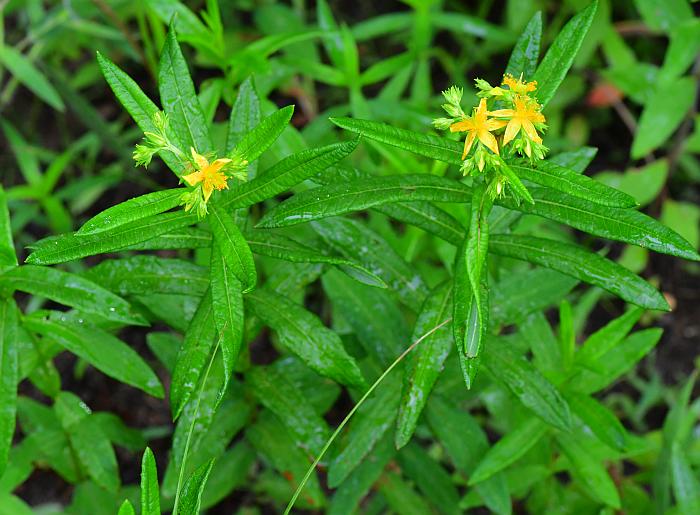Hypericum adpressum W.P.C. Barton
Creeping St. John's Wort

Native
CC = 10
CW = -5
MOC = 1
SRank = S1
© SRTurner
Hypericum adpressum W.P.C. BartonCreeping St. John's Wort | |
 |
Native CC = 10 CW = -5 MOC = 1 SRank = S1 |
© SRTurner |
|
Family - Hypericaceae Habit - Perennial forb, the rootstock and stem bases not woody, with well-developed, long-creeping rhizomes.
Stem - Ascending to erect, to 80 cm, occurring singly and scattered along the rhizomes, greenish and angled or slightly ridged below each leaf toward the tip, reddish brown and rounded toward the base, the surface usually not peeling with age, glabrous.
Leaves - Alternate, simple, sessile. Blades 20-80 mm long, 2-12 mm wide, narrowly oblong to narrowly elliptic, bluntly to sharply pointed at the tip, tapered or narrowed at the base, the margins somewhat rolled under at maturity, herbaceous to somewhat leathery in texture, with 3 main veins usually visible toward the base, the surfaces lacking noticeable black dots, lines, or streaks but usually with minute, faint, pale (pellucid) dots visible, the upper surface green, the undersurface usually pale green, but not glaucous.
Inflorescences - Terminal panicles of up to 80 flowers, rounded to more or less flat-topped in outline.
Flowers - Actinomorphic. Sepals 5, all more or less similar in size and shape, 3-7 mm long, not becoming enlarged at fruiting, lanceolate to ovate, the margins occasionally slightly curled, with pellucid dots but lacking noticeable black dots, lines, or streaks. Petals 5, 6-8 mm long, broadly oblanceolate to obovate, bright yellow, usually shed before fruiting. Stamens 60-80, the filaments not fused into groups. Ovary 1-locular or appearing partially 3-locular by intrusion of the parietal placentae into the locule. Styles 3, sometimes fused toward the base, erect and more or less appressed at flowering, persistent and usually separating somewhat as the fruit matures, the stigmas minute.
Fruits - Capsules 3.5-6.0 mm long, ellipsoid to ovoid, widest at or slightly below the midpoint, tapered abruptly to the minute beak (this sometimes absent), more or less circular in cross-section. Seeds numerous, 0.6-0.8 mm long, the surface with a network of ladderlike columns of fine ridges and pits, dark brown to nearly black.
Flowering - July - August. Habitat - Moist depressions in sand prairies, sandy pond margins, sandy banks of ditches. Origin - Native to the U.S. Lookalikes - Other species of Hypericum, particularly H. punctatum, H. sphaerocarpum. Other info. - This is a rare species of Hypericum. In Missouri it is known from only two counties. Beyond Missouri it ranges across several states within the eastern continental U.S., but is generally found only in a few widely scattered counties in each. It is considered uncommon everywhere. The plant is easily recognized as a Hypericum by its yellow flowers and opposite, sessile leaves having translucent (pellucid) dots. Key characters which point to this particular species include its long creeping rhizomes, which tend to form diffuse, loose colonies of plants, the lack of any black dots or markings on the foliage or calyces, and fruits which are ovoid and usually prominently beaked. Another important attribute is habitat, since this species is more or less obligate to moist, sandy substrate. Photographs taken at the Edgar W. Schmidt Sand Prairie, Scott County, MO, 8-8-2022, 10-4-2017, 7-12-2021, and 8-8-2022 (SRTurner). |